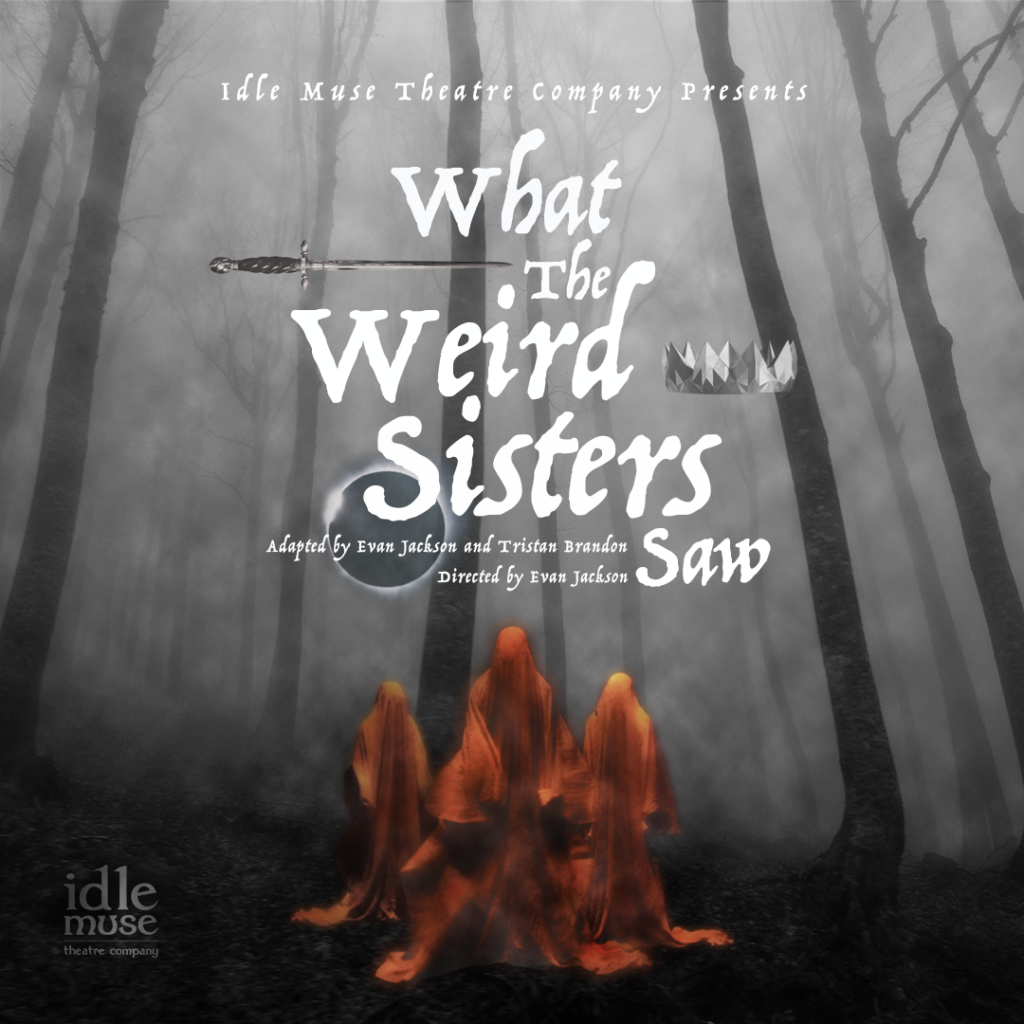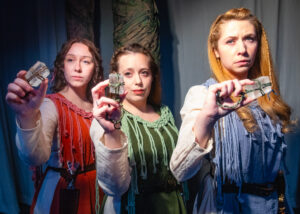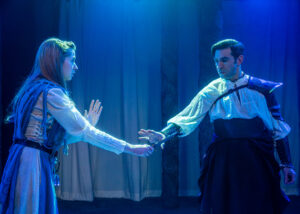
 *** Nobly directed by artistic director Evan Jackson, “What the Weird Sisters Saw” is a highly creative reimagination of Shakespeare’s “The Tragedy of Macbeth”, as performed by the Idle Muse Theatre Company. The weird sisters are akin to the three witches/spirits who open Shakespeare’s play and return throughout the text. In both plays, these witches could be thought to exist in the haze and fog of the unconscious mind, and they appear to several characters like Macbeth (Joel Thompson), Lady Macbeth (Mara Kovacevik), and Banquo (Troy Schaeflein). Often a foil for various characters’ thoughts, the sisters are largely Macbeth’s confidantes, who comfort him and reassure him when he chooses the course of his actions. They also prophesize murder and foretell that Macbeth will become king and that Banquo’s descendants will reign in medieval Scotland. Told from the spirits’ point of view, the story gives women a deeper, more empowering role in a setting where men are the usual and predominant movers and shakers of history. This adaptation by director Jackson and Tristan Brandon could thus be considered the mirror image of what Shakespeare once wrote.
*** Nobly directed by artistic director Evan Jackson, “What the Weird Sisters Saw” is a highly creative reimagination of Shakespeare’s “The Tragedy of Macbeth”, as performed by the Idle Muse Theatre Company. The weird sisters are akin to the three witches/spirits who open Shakespeare’s play and return throughout the text. In both plays, these witches could be thought to exist in the haze and fog of the unconscious mind, and they appear to several characters like Macbeth (Joel Thompson), Lady Macbeth (Mara Kovacevik), and Banquo (Troy Schaeflein). Often a foil for various characters’ thoughts, the sisters are largely Macbeth’s confidantes, who comfort him and reassure him when he chooses the course of his actions. They also prophesize murder and foretell that Macbeth will become king and that Banquo’s descendants will reign in medieval Scotland. Told from the spirits’ point of view, the story gives women a deeper, more empowering role in a setting where men are the usual and predominant movers and shakers of history. This adaptation by director Jackson and Tristan Brandon could thus be considered the mirror image of what Shakespeare once wrote.
The three weird sisters are the stars of the current production, and they each have names. Murron (Caty Gordon) is the chief prognosticator. She convinces the other two sisters Dana (Jennifer Mohr) and Alastriona (Jamie Redwood) that it is important to continually respond to Macbeth’s summons—and initially she doesn’t believe that his heart is evil. Rather, we see Macbeth as a character who often vacillates between ambition and guilt, filled with both bravery and self-doubt. He seeks certainty in his actions, which is one reason for consulting the spirits. Thus Shakespeare’s famous line “Fair is foul, and foul is fair” (that the witches recite at the beginning of the play) proves not so much to be a portent of things to come but, rather, points up a blind spot on the part of the spirits when they provide him with advice and counsel. Hecate (Elizabeth MacDougald) eventually chastises the three sisters for their willful ignorance of human nature—and for the confusion among them. Among my favorite characters is the Porter (Brandan Hutt), who guards Inverness Castle or, should I say, the descent into hell. His performance is light and funny and breaks up a rather serious and violent show. Other characters include Macduff (Watson Swift), Duncan (Erik Schnitger), and Malcolm (Orion Lay-Sleeper). What a brilliant acting job by all!
The main issue I had with the production is that the average audience member ought to have some previous familiarity with Shakespeare’s original play—both with its plotline and its characters—in order to fully understand and follow the current story. As for myself, I found it hard to piece things together as I was simultaneously recollecting the plot of “Macbeth” while noting the similarities and differences in this version. To put it another way, I was working much too hard with all my deciphering and comparing of stories that I really didn’t enjoy the show as much as I would have liked. I also couldn’t figure out how or why, in the second act, the three sisters became divided from each other. Yes, they would disagree among themselves, and each would have a different perspective on human beings and their foibles; but they always would work together as a team. What baffled me was how each of the sisters got drawn into human battles separately, and I never knew when or where this might happen. I also didn’t understand when and why they took human form to interact with people, and in so doing they became violent sorts: including among themselves. That said, it was interesting to note how they could be ethereal one moment and physical the next—and which humans paid attention to them and why.
This is a very physical script, and Libby Beyreis’s fight choreography makes the violence of war, the deliberate stabbings, and all the fight scenes appear realistic. Plus I really liked the sisters’ and Hecate’s ability to transcend dimensions and control each other’s movements from afar; this involves great timing among the actors. Text and dialect coach Carrie Hardin has done a great job with the Scottish dialects and getting the actors to speak in the vernacular of the Shakespearean era. Note that you have to be okay with listening to Shakespearian English; if not, you can become lost at the beginning (as my guest was) and never fully grasp what is going on.
Set design by Stina Taylor is simple, but it is the lighting and projection design by Laura Wiley that fully compliments it. The lights establish moods and scenes and help show up the violence; the precision involved in their color and timing is very nicely done. Lots of mist is used in this presentation to emphasize the mythical unreality of the dimension in which the spirits reside as well as the intersection between the netherworld and the human plane. Sound design and music design by L. J. Luthringer work well for this production.
Above all, costume design is extraordinary due to the incredible efforts by Jennifer Mohr. While all of the garb is exceptional and largely true to the time period, I especially loved how the three sisters are dressed with their respective light blue, soft deep coral, and soft green dresses with all sorts of lovely macramé around the collar and heavy strings that hang freely and extend to the skirt’s bodice. Then there are the giant off-white veils that cover their faces and go all the way down to the floor. Hecate wears a mystical looking dress with gold and satin and also sports an upside-down crescent moon on her forehead. The Porter’s bear-like fur costume is perfectly whimsical and clever with all sorts of totemic doodads hanging down his front.
The show’s focus on the weird sisters points up the many terrible things that can happen when spirits intervene in the course of human events. Specifically, this production emphasizes the extent to which Shakespeare’s “Macbeth” relies on witchcraft to tell its story. Just like the show “Wicked” was a deep dive into the story behind the witches that appear in “The Wizard of Oz”, “The Weird Sisters” is a deep dive into the witches of “Macbeth.” While gaining this background knowledge is certainly helpful in understanding the motivation behind the characters, the totality wasn’t as satisfying as I thought it would be. There were far too many moments when I was perplexed. A student of Shakespeare will probably grasp things better than I did.
“What the Weird Sisters Saw” is playing through April 14, 2024, at The Edge Off-Broadway Theatre, 1133 W. Catalpa Avenue, in Chicago.
Tickets are $30.
Seniors and students – $20.
Group Sales Available Upon Request
 Performance schedule:
Performance schedule:
Thursdays, Fridays, and Saturdays – 8:00 p.m.
Sundays – 3:00 p.m.
For more information and to purchase tickets, visit: http://www.idlemuse.org/productions
or https://app.arts-people.com/index.php?ticketing=imtc.
For additional information, please call 773-340-9438 or email BoxOffice@idlemuse.org.
To see what others are saying, visit www.theatreinchicago.com, go to Review Round-Up and click at “What the Weird Sisters Saw”.






More Stories
“The Magic School Bus: Lost in the Solar System”
“February House” reviewed by Julia W. Rath
” A Lie of The Mind”